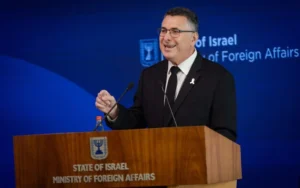Trump and Zelenskyy’s Critical Rome Meeting: Will Ukraine Finally See a Breakthrough in Peace Talks? This crucial meeting, held at the Vatican in Rome during Pope Francis’s funeral, marks a significant moment in the ongoing efforts to achieve peace between Ukraine and Russia.
Why Trump and Zelenskyy’s Meeting in Rome Matters for Ukraine’s Future
Former U.S. President Donald Trump and Ukrainian President Volodymyr Zelenskyy met privately on April 26, 2025, in Rome. This one-on-one discussion was the first since their tense Oval Office meeting in early 2024. The meeting’s timing — during the solemn gathering for Pope Francis — added weight to their conversations about ceasefires, peace negotiations, and Ukraine’s sovereignty.
Both leaders described their talks as “very productive,” yet serious differences remain, especially concerning territorial concessions.
Key Topics Discussed During the Trump-Zelenskyy Meeting
To help you understand what was at stake, here’s a clear table summarizing the major discussion points:
| Key Discussion Topic | Trump’s Approach | Zelenskyy’s Approach |
|---|---|---|
| Ceasefire | Supports immediate ceasefire | Agrees but demands withdrawal of Russian forces |
| Territorial Integrity | Open to compromise on seized areas | Demands full restoration of Ukraine’s borders |
| Sanctions Against Russia | Prefers easing some sanctions | Demands maintaining or strengthening sanctions |
| Future U.S. Support to Ukraine | Supportive but favors conditions | Seeks unconditional security guarantees |
This table shows that while both sides are open to peace, their visions differ sharply — especially on Ukraine’s territorial integrity.
What Trump’s Proposal Means for Ukraine’s Sovereignty
A major point of tension was Trump’s proposal suggesting that Russia could retain some occupied Ukrainian territories, including Crimea.
According to The Times, Trump’s plan is “set in stone” in his diplomatic team’s draft proposals.
Zelenskyy’s Response:
Zelenskyy firmly rejected any idea of territorial concessions, stating that Ukraine’s internationally recognized 1991 borders must be fully restored for peace to be legitimate.
Global Reactions: How the World is Viewing This Critical Meeting
Europe’s Standpoint
European Union leaders welcomed dialogue but warned that any peace agreement that compromises Ukraine’s sovereignty would be unacceptable.
Russia’s Response
The Kremlin remained silent publicly, but Russian media outlets signaled “optimism” that Trump’s approach might favor Moscow’s interests.
United Nations’ Statement
The UN called for further direct negotiations and emphasized the need for a peace settlement that respects Ukraine’s full territorial rights.
How American Public Opinion Could Shape Future Negotiations
Recent Pew Research Center polling (April 2025) shows:
- 72% of Americans support diplomatic efforts toward ending the Ukraine war.
- Only 38% of Americans support Ukraine making any territorial compromises.
This shows that public sentiment in the U.S. heavily favors a peace deal that preserves Ukraine’s territorial integrity — aligning closely with Zelenskyy’s stance.
Challenges Ahead: What’s Next After the Rome Meeting?
Although Trump and Zelenskyy have reopened diplomatic channels, several challenges remain:
| Challenge | Impact |
|---|---|
| Deep mistrust between Ukraine and Russia | Delays progress |
| Differences on territorial concessions | Major negotiation obstacle |
| External influences (EU, China) | Complicate peace talks |
| Domestic politics in USA and Ukraine | Influence leaders’ flexibility |
Future talks are expected later this year, possibly involving European leaders and the UN, to create a broader peace framework.
Conclusion: Will This Rome Meeting Lead to Real Peace?
Trump and Zelenskyy’s Critical Rome Meeting: Will Ukraine Finally See a Breakthrough in Peace Talks? The Rome meeting marks an important diplomatic step but achieving real peace remains extremely challenging.
Both leaders agree on ending violence but fundamentally disagree on the terms. For the Ukrainian people, complete territorial sovereignty is non-negotiable. For Trump, a pragmatic compromise might seem more realistic.
In the coming months, how these negotiations evolve — and how international pressure builds — will determine whether real peace is finally within reach.
[USnewsSphere.com / tt.]





